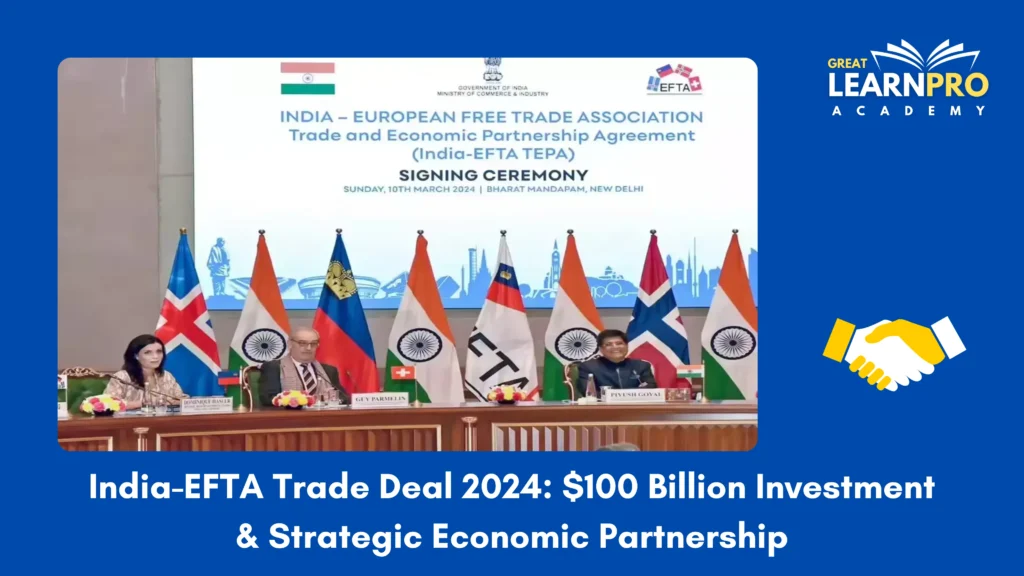
Introduction
On 10 March 2024, India signed a landmark Trade and Economic Partnership Agreement (TEPA) with the European Free Trade Association (EFTA) comprising Switzerland, Norway, Iceland, and Liechtenstein. This agreement represents a new generation Free Trade Agreement (FTA) and is one of India’s most ambitious trade pacts in recent years. It aims to enhance bilateral trade, investment flows, and cooperation in key areas such as sustainable development, intellectual property, and digital trade.
The India-EFTA TEPA is not just about reducing tariffs — it’s about creating a long-term economic and strategic partnership between a major emerging market and a bloc of highly developed economies.
Background: Who is EFTA?
The European Free Trade Association (EFTA) is a regional trade bloc formed in 1960 as an alternative to the European Union. Unlike the EU, EFTA does not aim for political integration. It focuses solely on promoting free trade and economic cooperation. Its four member countries are:
- Switzerland
- Norway
- Iceland
- Liechtenstein
These nations are among the wealthiest and most developed globally, and together they represent a combined GDP of over USD 1.1 trillion.
Key Highlights of the India-EFTA TEPA
🔹 Market Access and Tariff Reduction
India will gradually reduce or eliminate tariffs on a significant number of goods imported from EFTA countries, including pharmaceuticals, machinery, watches, and chemicals. In return, EFTA nations will provide better access for Indian exports in services, IT, and skilled labour.
🔹 Investment Commitments
A first-of-its-kind provision in this agreement is the investment commitment by EFTA. The bloc has promised to bring in USD 100 billion in investments into India over the next 15 years and generate over 1 million jobs. This clause makes TEPA stand out among India’s other FTAs.
🔹 Services and Mobility
India has secured liberalised access for Indian professionals and service providers, especially in IT, education, engineering, and healthcare. This will benefit Indian workers seeking opportunities in high-income countries like Switzerland and Norway.
🔹 Intellectual Property and Innovation
The agreement strengthens cooperation in intellectual property rights, R&D, and innovation, providing a framework for better technology transfer, collaboration in clean energy, and digital trade.
🔹 Sustainable Development
A chapter is dedicated to sustainability, including commitments on labour rights, environmental protection, and climate action. This is in line with India’s global positioning as a responsible power on environmental issues.
Strategic and Economic Significance for India
🔸 Diversifying Trade Partners
This agreement helps India reduce its over-dependence on China and the US by deepening ties with high-income European economies. EFTA is now India’s gateway to richer, niche markets in Europe that have high purchasing power.
🔸 Boosting Make in India and Manufacturing
The inflow of investment is expected to bolster India’s manufacturing base, create jobs, and integrate Indian firms into global value chains, particularly in high-tech sectors.
🔸 Enhancing Services Sector
The liberalisation of services trade is a big win for India, whose strength lies in IT and knowledge-based services. TEPA facilitates smoother entry of Indian professionals into high-paying markets.
EFTA’s Perspective
For EFTA, India offers a vast and growing market of over 1.4 billion people. The agreement gives EFTA firms preferential access to one of the fastest-growing economies in the world. Additionally, it provides a counterbalance to rising protectionist trends elsewhere.
Challenges and Criticisms
Despite its positive outlook, the agreement has its critics:
- Some Indian industry groups fear increased competition from duty-free imports of Swiss goods (e.g., watches, chocolates).
- Concerns over intellectual property provisions affecting access to affordable generic medicines.
- Questions on whether the USD 100 billion investment commitment is legally binding or just aspirational.
However, the government has responded that protective measures have been included for sensitive sectors, and that TEPA will be implemented with safeguards and timelines to avoid sudden shocks.
Conclusion
The India-EFTA TEPA is a forward-looking agreement that reflects India’s evolving approach to trade diplomacy. Unlike earlier FTAs that focused only on tariffs, this one incorporates investment, sustainability, and skill mobility, making it a comprehensive economic partnership.
It marks India’s growing confidence in engaging with developed nations on equal and mutually beneficial terms. If implemented effectively, it could become a template for future trade agreements and play a significant role in India’s journey towards becoming a $5 trillion economy.
Sources:
- https://www.pib.gov.in/PressReleaseIframePage.aspx?PRID=2013169&utm_
- https://www.ft.com/content/f6933d76-d811-4ce7-be8d-832295e4fcfe?utm_
- https://m.economictimes.com/news/economy/foreign-trade/indias-trade-agreement-with-efta-to-boost-investments-by-100-billion/articleshow/121736665.cms?utm_
- https://timesofindia.indiatimes.com/business/india-business/india-efta-trade-deal-to-take-effect-october-1-piyush-goyal-confirms-implementation-timeline-100-billion-investment-and-1-million-jobs-expected/articleshow/122780873.cms?utm_
More Current Affairs: https://learnproacademy.in/updates/
